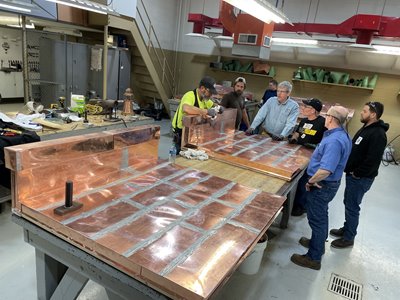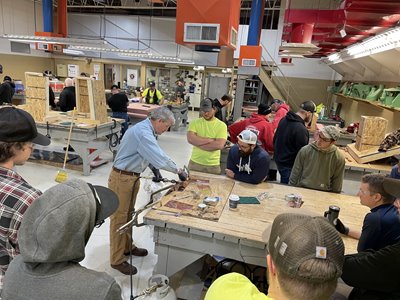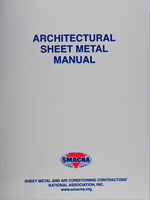 The city of Detroit is roaring back to life. “Over the last 10 years, Detroit has become a more vibrant city,” says Glenn Parvin, owner of Custom Architectural Sheet Specialists in Detroit. “Its rebirth is stunning.” CASS is a key player in one of the city’s most significant historical restorations, the renovation of Michigan Central Station. The 1913 landmark anchors the new Michigan Central Innovation District. “It’s a very important project for the Ford Motor Company,” Parvin says. “This will be the autonomous vehicle headquarters, with public space down low.”
The city of Detroit is roaring back to life. “Over the last 10 years, Detroit has become a more vibrant city,” says Glenn Parvin, owner of Custom Architectural Sheet Specialists in Detroit. “Its rebirth is stunning.” CASS is a key player in one of the city’s most significant historical restorations, the renovation of Michigan Central Station. The 1913 landmark anchors the new Michigan Central Innovation District. “It’s a very important project for the Ford Motor Company,” Parvin says. “This will be the autonomous vehicle headquarters, with public space down low.”
With a portfolio full of copper projects and a recent copper soldering training from the International Training Institute, CASS was the obvious choice to replace the building’s classic copper roof. Parvin has encouraged ITI to strengthen copper training since he served on SMACNA’s Architectural Steering Committee. “I’m grateful that Mike Harris and Dan McCallum made copper certification a reality,” he says. “When this certification came to fruition, I wanted Detroit to be one of the first participants in the process.”
“It was a no-brainer to host ITI’s copper certification Strike Force,” says Matt O’Rourke, training director for the Local 80 JATC, who was supported by Sam Velez, Local 80’s architectural sheet metal instructor, and retired training director Richard Flood. “These skills increase work hours for members and market share for contractors."
 ITI does not charge for Strike Force training. “The local JATC just picks up the cost of the materials and training supplies,” explains Chris Caricato of ITI. JATCs can apply for the ITI grant program, which may offset up to 50% of costs. Apprentices spend the first 16 hours on soldering training, which includes the fabrication and installation of a copper roof onto mockup structures as well as soldering training for both a horizontal three-quarter inch flatlock seam and a one-inch vertical lap seam. On the third day, they take the American Welding Society (AWS) B2.3: 2018 Specification for Soldering Procedure and Performance Qualification Exam.
ITI does not charge for Strike Force training. “The local JATC just picks up the cost of the materials and training supplies,” explains Chris Caricato of ITI. JATCs can apply for the ITI grant program, which may offset up to 50% of costs. Apprentices spend the first 16 hours on soldering training, which includes the fabrication and installation of a copper roof onto mockup structures as well as soldering training for both a horizontal three-quarter inch flatlock seam and a one-inch vertical lap seam. On the third day, they take the American Welding Society (AWS) B2.3: 2018 Specification for Soldering Procedure and Performance Qualification Exam.
Six companies sent a total of twenty employees for certification. Apprentice Sergiy Bonderchuk from Detroit Cornice and Slate was in the first class. Bonderchuk expects to use his new skills often, “probably at least three times a week.”
CASS sent Foreman Jeff Sanders, who has over 20 years of experience with soldering. “The strike force showed me new tools that improve the soldering experience,” he says. “The testing process helps by giving you a standard to meet. You want to pass the certification.”
Certified expertise is vital on copper jobs, which are often high-profile. “Owners that use copper are looking for 100-year performance,” says Larry Peters of the Copper Development Association, who partnered with ITI to deliver the training. Thermal movement will crack copper roofs that don’t have proper soldering. “SMACNA members don't want callbacks for poor installation, which could lose money and tarnish their reputation. Training can also help contractors expand into areas they have previously shied away from.”
Eric Sassak of SmithGroup visited the JATC to observe training. “It was inspiring to see these dedicated people refining their trade,” he says, “as they were shepherded through certification.” SmithGroup loves architectural copper. “It’s durable, it’s beautiful, and it really performs.”
CASS will use their expertise to replace the most visible copper on the Michigan Central Station, the front lower roof. The eave is 65 feet above the ground, and the ridge is about 90 feet up. For safety reasons, CASS only goes onsite when other people are not working above them on the 13-story office tower. Parvin knew about the limited scheduling, but prepping the roof became a surprising challenge. “One of our tasks was to remove the original shale on the concrete deck, and that's been proven to be very difficult,” he says. “We took jackhammers up to finish off the shale.”
The roof surface is about 27,000 square feet of copper batten seam and flat seam roofing. It uses a double lock system with large wide-profile battens in 3.5 inches, plus or minus 24 inches on center. The proper roof comes out of 24-inch stock. The panels are folded over and double locked on each side. CASS used a custom-built rollformer and seamer on a previous project. Parvin had the seamer modified for this new project “to tie new production technologies in with old-world craftsmanship.”
The escalation of materials is a reality in the current market. When he bid on the job, Parvin estimated that plywood would be about $36 per sheet, but it went as high as $90 or $95 a sheet. Insulation is another concern. Parvin ordered isocyanurate several different times from multiple sources to keep the job rolling. “In the roofing industry, if contractors order insulation today, they might get it early next year, with a price adjustment at the time of shipping,” he says. “There are lots of delays on construction sites due to shortages of installation.” CASS planned ahead by purchasing the needed 35,000 pounds of copper well in advance, before a recent jump in prices. “Lead times for copper right now are 10 to 12 months, so the copper is sitting at the warehouse.”
To keep contaminants off the new roof, CASS will not lay the copper until the office tower has been spray cleaned. “We expect to run that job with seven or eight workers but might beef up to 10,” Parvin says. Installation will take 18 to 20 weeks.
 This completely revised publication contains the most comprehensive set of recommended practices available for proper design and installation of custom-fabricated architectural sheet metal, including roof drainage system design for scuppers, gutters and downspouts. Applies to commercial, industrial and residential buildings. Get it here: https://rb.gy/pvktx6.
This completely revised publication contains the most comprehensive set of recommended practices available for proper design and installation of custom-fabricated architectural sheet metal, including roof drainage system design for scuppers, gutters and downspouts. Applies to commercial, industrial and residential buildings. Get it here: https://rb.gy/pvktx6.